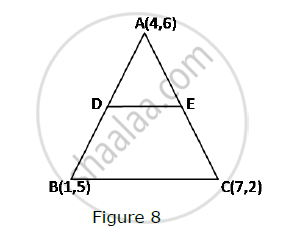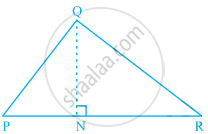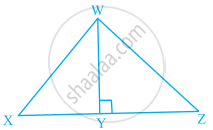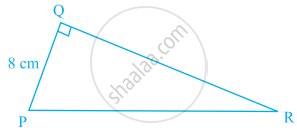Advertisements
Advertisements
प्रश्न
In Fig. 8, the vertices of ΔABC are A(4, 6), B(1, 5) and C(7, 2). A line-segment DE is drawn to intersect the sides AB and AC at D and E respectively such that `(AD)/(AB)=(AE)/(AC)=1/3 `Calculate th area of ADE and compare it with area of ΔABCe.

उत्तर
`(AD)/(AB)=(AE)/(AC)=1/3`
`:.(AB)/(AD)=(AC)/(AE)=3`
`:.(AD+DB)/(AD)=(AE+EC)/(AE)=3`
`:.1+(DB)/(AD)=1+(EC)/(AE)=3`
`:.(DB)/(AD)=(EC)/(AE)=2`
`:.(AD)/(DB)=(AE)/(EC)=1/2`
∴ AD:DB = AE :EC = 1: 2
So, D and E divide AB and AC respectively in the ratio 1:2.
So the coordinates of D and E are
`((1+8)/(1+2),(5+12)/(1+2))=(3,17/3) `

Area of ΔADE
`=1/2|(4xx17/3+3xx14/3+5xx6)-(3xx6+5xx17/3+4xx14/3)|`
`=1/2|(68/3+14+30)-(18+85/3+56/3)|`
`=1/2|((68+42+90)/3)-((54+85+56)/3)|`
`=1/2|(200/3)-(195/3)|`
`=1/2xx5/3`
`=5/6 `

Area of ΔABC
`=1/2|(4xx5+1xx2+7xx6)-(1xx6+7xx5+4xx2)|`
`=1/2|(20+2+42)-(6+35+8)|`
`=1/2|64-49|`
`=15/2`
`:.(`
APPEARS IN
संबंधित प्रश्न
If A(−4, 8), B(−3, −4), C(0, −5) and D(5, 6) are the vertices of a quadrilateral ABCD, find its area.
Find the area of the triangle whose vertices are: (–5, –1), (3, –5), (5, 2)
Find the area of the triangle formed by joining the mid-points of the sides of the triangle whose vertices are (0, -1), (2, 1) and (0, 3). Find the ratio of this area to the area of the given triangle
The four vertices of a quadrilateral are (1, 2), (−5, 6), (7, −4) and (k, −2) taken in order. If the area of the quadrilateral is zero, find the value of k.
If the coordinates of the mid-points of the sides of a triangle are (3, 4) (4, 6) and (5, 7), find its vertices.
The points (0, 5), (0, –9) and (3, 6) are collinear.
Find the area of the triangle whose vertices are (–8, 4), (–6, 6) and (–3, 9).
Area of triangle PQR is 100 cm2 as shown in the below figure. If altitude QT is 10 cm, then its base PR is ______.

Ratio of the area of ∆WXY to the area of ∆WZY is 3:4 in the given figure. If the area of ∆WXZ is 56 cm2 and WY = 8 cm, find the lengths of XY and YZ.

Area of a triangle PQR right-angled at Q is 60 cm2 in the figure. If the smallest side is 8 cm long, find the length of the other two sides.

